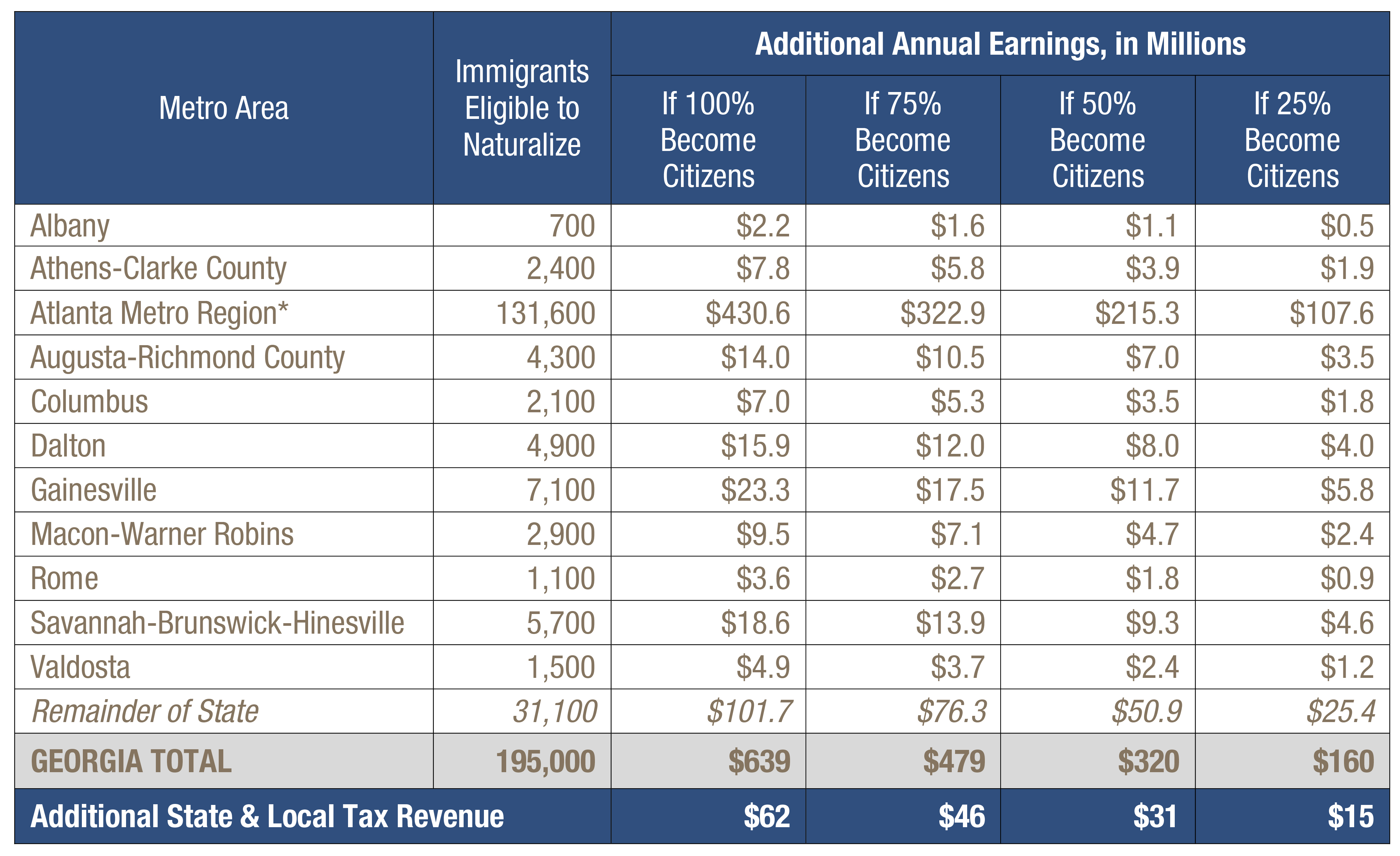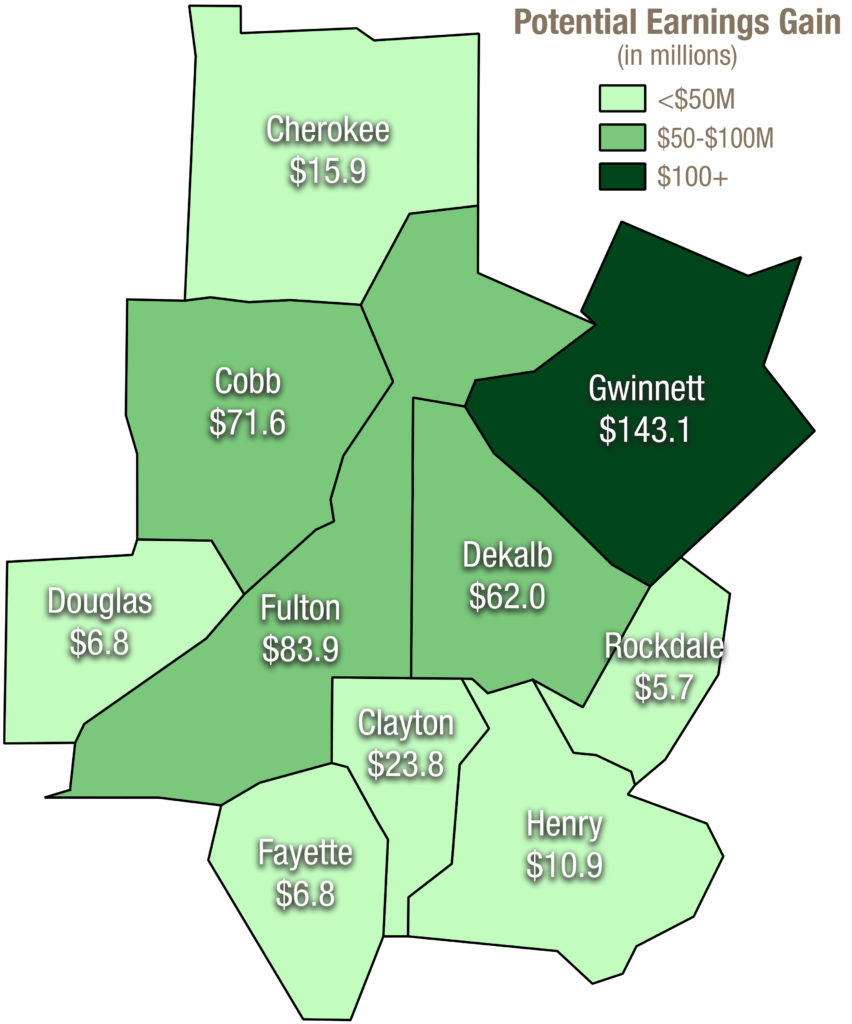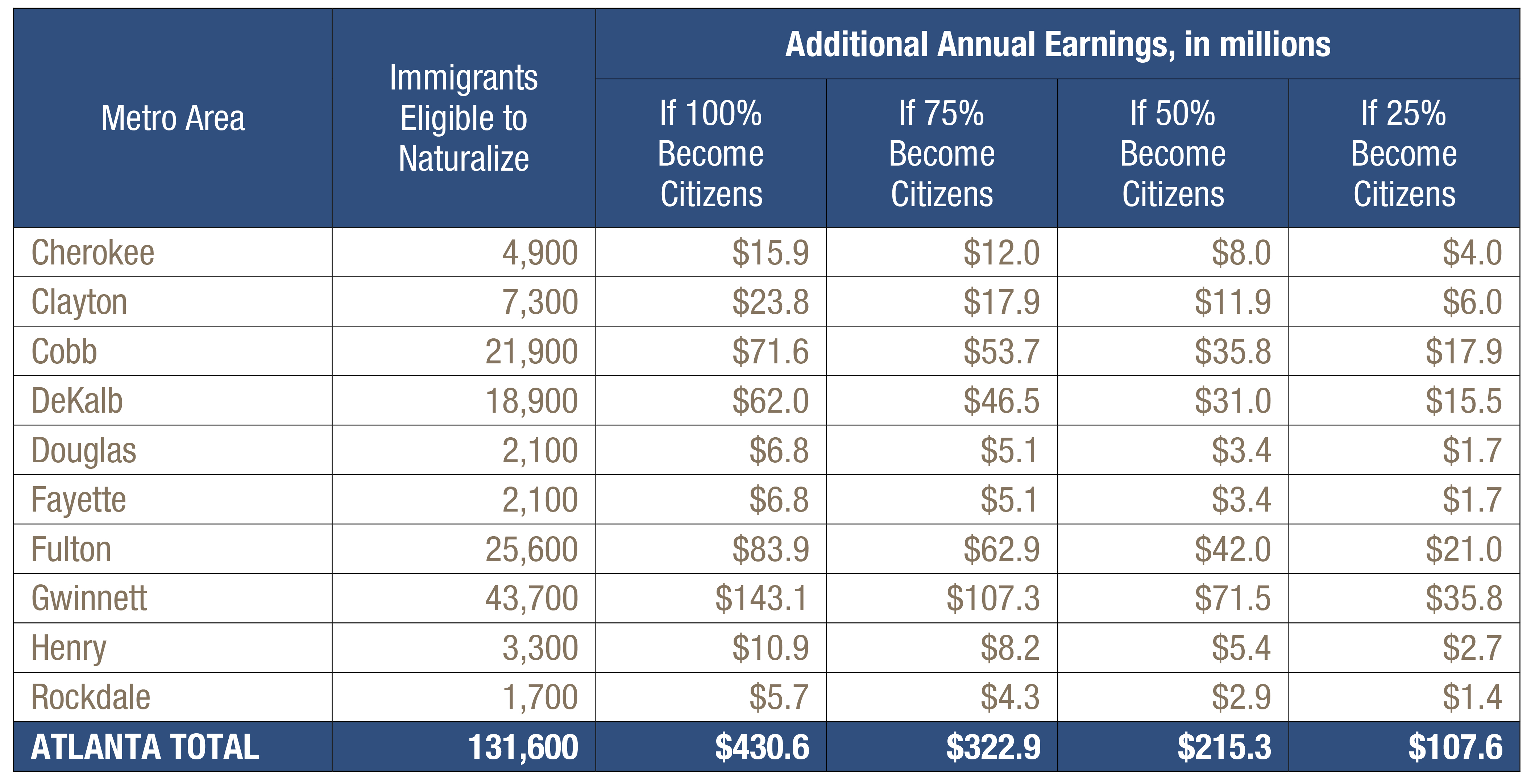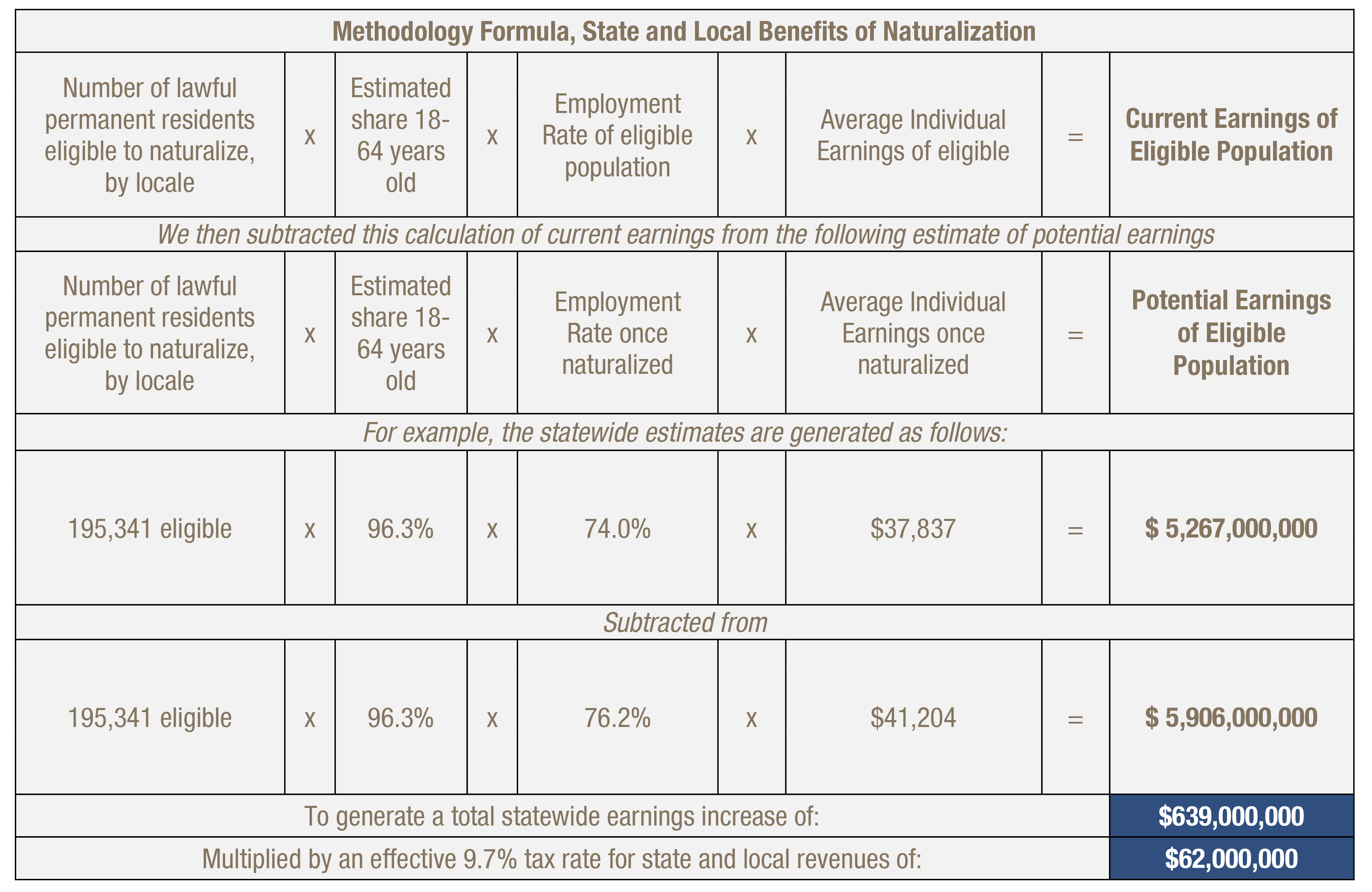States and cities nationwide are discovering they can strengthen their local economies and boost tax revenues by encouraging immigrants legally in the country on a permanent basis to become citizens. About 9 million people nationwide live in the country as lawful permanent residents and are eligible to become naturalized citizens[1], including an estimated 195,000 in Georgia.[2] But fewer than 10 percent each year complete the process to become citizens of the United States, in part because the process is lengthy, complex and costly. A concerted effort by Georgia lawmakers and community leaders to encourage lawful permanent residents to become citizens and smooth their path could add up to $639 million in annual earnings to the state’s economy and as much as $62 million a year in state and local tax revenue.
Research indicates that naturalization offers many benefits to immigrants themselves and the broader community. Lawful permanent residents who take the steps to become citizens tend to work at slightly higher rates, earn higher wages and are likelier to become homeowners. That added financial security means extra dollars circulate through the economy and translate into higher state and local tax collections. In recent years, places as different as New York City and Knoxville moved to maximize those benefits by improving public policies and working with community leaders to encourage more lawful immigrants to become citizens. Georgia’s local officials and state policymakers can join the club and provide a needed boost to communities statewide.
Two Key Immigration Terms, DefinedLawful permanent resident – Lawful permanent residents, sometimes known as green card holders, are immigrants residing in the country on a legal, long-term basis. They can work with some restrictions, own homes and businesses, receive financial aid for higher education and join the military. Common reasons immigrants gain lawful permanent status are if they are immediate family members of citizens, if they possess sought-after skills or if they are refugees. About 13 million people are lawful permanent residents nationwide. About two-thirds of them likely meet the eligibility requirements to become citizens.[3] Naturalization – Naturalization is the official process for lawful permanent residents to complete required steps to become U.S. citizens. The process is lengthy, complicated and often costly. Immigrants who become naturalized must pass a test on U.S. civics, clear a criminal background check, pay a fee of $725 in most cases and speak at least passable English. Once approved, naturalized citizens enjoy the same rights and responsibilities as native-born Americans, including the ability to vote, serve on a jury, travel with a U.S. passport and sponsor family members to immigrate. Less than 10 percent of eligible lawful permanent residents naturalize each year. |
Citizenship Can Benefit Both Immigrants and the Broader Community
About 1 million Georgians, or one in 10 state residents, is foreign born.[4] Those immigrants fall into three broad categories: naturalized citizens, unauthorized immigrants and lawful permanent residents. An estimated 260,000 lawful permanent residents called Georgia home in 2014, according to the U.S. Department of Homeland Security.[5] Not all of these permanent residents can become citizens, due to a complex range of eligibility requirements.[6] But an estimated 195,000 immigrants living in Georgia on a lawful basis are eligible to naturalize.[7] That’s equivalent to 2 percent of the state’s entire population.
One in Five Georgia Immigrants Eligible for Citizenship

Citizenship Confers Range of Benefits on Immigrants

Gaining citizenship provides many concrete benefits to immigrants and their families. Immigrants typically enjoy a modest citizenship premium after they choose to naturalize, receiving higher earnings, better job prospects and a greater likelihood of homeownership. Gaining citizenship leads to a slight increase in employment rates, according to a detailed 2015 analysis by the Urban Institute. It also boosts earnings among the eligible-to-naturalize population by 8.9 percent, to $39,500 a year from $36,300, the study says.[8] That is in line with similar studies, which find that naturalization can increase earnings by 4 to 15 percent once adjusting for underlying differences in people’s education levels, language ability and other variables.[9]
There are a few key reasons why gaining citizenship can boost wages, both right away and in the long-run. Some professions such as state and local peace officers and jobs with the federal government are only available to citizens, so naturalization opens a broader pool of available jobs. Some private employers could also prefer naturalized workers as a signal of long-term commitment and permanence, leading them to invest more in their wages and employee training.[10] Wages can rise more in the long run because immigrants who become citizens are more likely than before to move into white-collar occupations that pay more.[11] With increased earnings comes an increased ability to buy property for a home or small business. The Urban Institute study estimates a concerted push to naturalize eligible immigrants could increase their homeownership rate to 35 percent from 29 percent.
Citizenship is important for less tangible reasons as well. Immigrants who naturalize enjoy the full slate of rights and privileges available to native-born Americans, including the right to vote, run for office, travel with a U.S. passport and petition for visas for immediate family members living abroad. These rights can foster a heightened sense of belonging and full inclusion as part of the American experiment. Naturalized citizens often become trusted mentors and leaders in their local communities, helping assist other immigrants navigate unfamiliar laws and customs and helping native-born residents connect with newcomers. Political representation also makes it more likely for a community’s voice to be heard by elected officials and other policymakers, which can result in better services like schools and improve economic outcomes long-term.
Immigrants who complete the process to become citizens receive essential legal protections as well. Naturalized citizens cannot be deported, unlike those with more temporary status. Lawful permanent residents account for an estimated 10 percent of people deported from the U.S. each year, typically for overstaying visas or due to nonviolent legal infractions.[12] A desire for stronger legal protection is among the reasons why applications for U.S. citizenship in 2016 jumped 24 percent over 2015, soaring to their highest point in two decades.[13]
Gains from Citizenship Extend to Broader Community and Economy
As naturalized immigrants earn more wages and secure better jobs, the resulting extra dollars circulate through the state and local economy. Wage increases from naturalization could lead to $21 billion to $45 billion in new earnings nationwide over 10 years, depending on how rapidly citizenship gains occurred, according to a rigorous 2012 study.[14] The 2015 Urban Institute report estimates that full-scale naturalization across 21 target cities could generate $5.7 billion in additional earnings, including $148 million in the City of Atlanta.[15] As workers earn more, they pump more dollars back into local shops, restaurants and other economic generators.
The additional economic activity translates into higher state and local tax collections over time. Naturalized immigrants in the 21 target cities would pay $2 billion more in federal and state income and payroll taxes, the Urban Institute estimates. Sales and property taxes would also naturally increase, since workers with more disposable income pay more in sales taxes and adding new homeowners to the rolls results in more property tax for local governments.
More Citizens Equal More Dollars for Georgia Communities
States and cities nationwide are working to maximize the benefits of citizenship by improving public policies and working with community leaders to encourage naturalization among qualified immigrants. By following suit, Georgia’s local communities could see a modest yet noteworthy long-term boost to local economies.
If the 195,000 eligible lawful permanent residents living in Georgia naturalized, the state could eventually gain up to $639 million in earnings and $62 million in state and local tax revenues a year, according to GBPI estimates. Potential gains vary depending on how many immigrants naturalize and how long it takes to reach target benchmarks. If Georgia’ entire eligible population naturalized over 10 years, the state could see an estimated $3.5 billion in new earnings and collect an $330 million more in state and local tax revenue in that decade.[16] Nationwide, about 60 percent of permanent residents eventually choose to naturalize.[17]
The table below provides detailed estimates for potential annual earnings Georgia’s metro areas could realize from a concerted push for citizenship. Metro Atlanta[18], home to more than two-thirds of the state’s total immigrant population[19], naturally sees the largest gain, with up to $431 million in estimated new annual earnings. Georgia’s smaller metro regions see smaller yet noteworthy increases. The local economies for Gainesville, Dalton, Augusta and the broader Savannah area would realize the largest gains outside Atlanta.
Promoting Citizenship Can Add More Dollars to Georgia’s Local Economies

About two-thirds of lawful permanent residents eligible to naturalize in Georgia live in the metro Atlanta region. The map below takes a detailed look within the region to calculate the potential earnings gain in specific counties. Gwinnett County is home to nearly 44,000 eligible immigrants and stands to gain the most of any county in state, with a gain of up to $143 million a year in potential earnings. Fulton, Cobb and DeKalb counties follow with sizable gains in the tens of millions annually. The metro Atlanta region as a whole could eventually gain an estimated $431 million in additional yearly earnings if all eligible immigrants enrolled. If the region reached that 100 percent mark over 10-years, its economy could realize an estimated $2.4 billion in new earnings that decade.[20]
Metro Atlanta’s Local Economies Could Benefit from Citizenship Push
Increase in annual earnings if 100 percent of eligible population naturalizes; $431 million region total

Georgia Communities Can Smooth Steps to Citizenship to Maximize Benefits
Despite the many benefits of citizenship, fewer than 10 percent of qualified, lawful permanent residents become naturalized each year. The costs and complexity of the process are oft-cited barriers. Immigrants who naturalize must pass a U.S. civics test, clear a criminal background check and usually pay a $725 federal fee.[21] They also need to speak at least passable English. Evidence suggests the language requirements may be the steepest barrier, followed by cost. Although most immigrants who take the citizenship test pass the English language and civic portions, many immigrants with low English proficiency may not reach the point of taking the test in the first place. To afford the test, one survey found that a quarter of immigrants had borrowed money to cover the application fee and more than two-fifths had postponed their application due in part to cost concerns.[22]
State and local governments trying to maximize the value of citizenship worked to smooth the process in recent years. Through efforts such as the Cities for Citizenship initiative that launched in 2013, places as different as New York City and Knoxville worked to promote citizenship in local immigrant communities and enact public policies that make it easier to naturalize. Since 2016, the number of cities joining this national effort to boost citizenship rates doubled to 38.[23]
Local governments are working in partnership with community leaders and nonprofit organizations to offer English language programs, provide civics courses and mitigate the cost of naturalization. Local governments can also start small by providing easy access to resources to educate eligible immigrants about naturalization and get them started on the process. For example:
- Knoxville – In 2016 the mayor brought together several nonprofits, churches and local supporters to form a coalition to better connect immigrants with information about becoming a citizen and to streamline available services such as English language training.[24] The mayor also uses his bully pulpit to raise awareness about citizenship by attending cultural festivals and hosting naturalization ceremonies.[25]
- Atlanta – Georgia’s capital city is the state’s only local government now enrolled in the Cities for Citizenship project. Among its projects are offering free English language courses through the public school system[26], setting up “citizenship corners” of educational resources at local libraries and community centers[27] and connecting people with nonprofit partners such as New American Pathways that offer additional services.[28]
- Seattle – The city drew attention in 2016 when city lawmakers struck a partnership with local credit unions to offer eligible immigrants low- to no-interest loans to cover the $725 federal fee.[29] For eligible immigrants who are of modest means, the steep upfront fee can prove prohibitive to even starting the citizenship process.
State government can play a role as well. Fewer than 12,000 Georgians a year are served by English language programs, a tiny fraction of what’s needed. An estimated 45 percent of immigrants in Georgia speak English “less than very well” and about 500,000 children live with at least one immigrant parent.[30] Thirty-seven states spend more than Georgia on all adult education services, including English as a Second Language classes.[31] This low funding means even immigrants who want to learn English and become citizens have trouble finding a class.
Possible Shift in Federal Immigration Policy Could Sway Georgia’s Gains from Citizenship
Lawmakers in Washington, D.C. are set to consider a possible sweeping shift in the nation’s approach to legal immigration that could undermine Georgia’s potential gains from adding more citizens.
The Reforming American Immigration for Strong Economy Act, commonly known as the RAISE Act, was introduced in the Senate in August 2017 by senators David Perdue (R-Ga.) and Tom Cotton (R-Ark.). It would slash legal immigration to the U.S. in half over a decade, sharply curtailing the future pool of new citizens.[32] The act proposes to replace the country’s long-standing family-based immigration system, which prioritizes reuniting legal immigrants with children and immediate relatives, with a points-based system where potential entrants get extra credit for characteristics such as speaking English or holding advanced degrees. The bill also creates barriers for legal immigrants and their families to access resources such as basic health care and nutrition assistance and makes it harder to become naturalized for people who received temporary public benefits.[33]
Fewer legal immigrants arriving in Georgia and steeper obstacles to citizenship for those already living here means fewer workers, entrepreneurs and taxpayers in the state long-term. That trend would decrease the level of economic activity immigrants bring to the state and, in turn, the amount of tax revenue and other contributions they provide to their local communities.
In contrast, Congress may also consider a new version of the DREAM Act, a longstanding bipartisan plan to provide a path to citizenship for young immigrants brought to the U.S. as children, or “Dreamers.” This development is in response to President Donald Trump’s announcement in early September 2017 to rescind the protections provided to Dreamers through the Deferred Action for Childhood Arrivals program, or DACA. Later in the month the president sent mixed signals about the future of the program. Launched in 2012, DACA allows young immigrants brought to the U.S. by their parents to apply for a renewal two-year permit to work, avoid deportation and go to college in some cases. About 47,000 Georgians, most of them in their teens or early 20s, either received DACA protections or were immediately eligible to apply before the September announcement.
Dreamers in Georgia already contribute an estimated $66 million a year in state and local tax revenue[34] and earn nearly $800 million in wages.[35] But if DACA recipients lose their lawful status or are deported, Georgia will lose much of their contribution as well as future benefits. Following bipartisan proposals to treat Dreamers fairly by putting them on a gradual path to citizenship, however, would further bolster the potential gains from naturalization outlined in this report.
Conclusion
Research indicates that naturalization brings many benefits to immigrants and the broader community. Lawful permanent residents who make the considerable effort to become citizens tend to work at slightly higher rates, earn higher wages and are likelier to become homeowners. That added financial security means extra dollars circulate through the economy and translates into higher state and local tax collections. In recent years, a diverse coalition of local governments nationwide have moved to maximize those benefits by improving public policies and working with community leaders to encourage more lawful immigrants to become citizens. Georgia localities as well as the state government itself can join the club and provide a needed boost to communities statewide.
Appendix: More Details on Potential Gains for Metro Atlanta
The table below includes estimates for the potential amount of earnings counties within Metro Atlanta could see from a concerted push for citizenship. It provides a further level of detail than the map provided on page 5. Potential economic gains could reach $431 million a year for the region if the entire eligible population naturalized, or $215 million a year if only half did.
Metro Atlanta Counties Could See Big Gains from Citizenship Push

Methodology
This analysis generates estimates of how the earnings and tax payments of lawful permanent residents in Georgia would change depending on how many choose to naturalize, using the following pieces of information.
- The number of lawful permanent residents eligible for citizenship in Georgia’s metropolitan statistical areas (MSA) and counties. The University of Southern California Institute on the Study of Immigrant Integration estimates that about 195,000 immigrants in Georgia meet those criteria.[36] Data from the institute are available at the state and MSA levels and, in some cases, for counties and a smaller designation known as Public Use Microdata Areas (PUMAs) as well.
- How naturalization affects employment Raising citizenship levels increased employment by 2.2 percentage points from 74 percent to 76.2 percent among eligible immigrants aged 18-64 in a large national sample studied by the Urban Institute in 2015. Our calculations use five-year data from the 2014 American Community Survey to make a small adjustment to the University of Southern California data to limit the population of potential workers to people aged 18-64.
- How individual earnings of eligible immigrants change due to naturalization. The 2015 Urban Institute study found an earnings increase of 8.9 percent among eligible immigrants who naturalize, raising wages among that community nationwide from $36,300 to $39,500. We adjust the starting point for eligible immigrants’ earning level to about $37,840 to account for inflation.
- The effective state and local tax rate paid by Georgians at varying levels of income. Both lawful permanent residents and citizens earning $30,000 to $49,000 a year contribute an estimated 9.7 percent[37] of their income on average in state and local taxes, according to the Institute on Taxation and Economic Policy.
 Endnotes
Endnotes
[1] “The Economic Impact of Naturalization on Immigrants and Cities,” Urban Institute. December 2015.
[2] Interactive Map: Eligible to Naturalize Populations in the United States. University of Southern California Institute for the Study of Immigrant Integration. Accessed July 2017.
[3] “Estimates of the Lawful Permanent Resident Population in the United States: January 2014,” United States Department of Homeland Security.
[4] American Community Survey 2010-2014 five-year estimates. For more details on the makeup and contributions of Georgia’s foreign-born population, see “Immigrants Help Chart Georgia’s Course to Prosperity,” GBPI. December 2015.
[5] “Estimates of the Lawful Permanent Resident Population in the United States: January 2014,” United States Department of Homeland Security.
[6] A Guide to Naturalization, U.S. Citizenship and Immigration Services. Accessed July 2017.
[7] USC Institute for the Study of Immigrant Integration
[8] Urban Institute
[9] In general, naturalized citizens earn higher wages, are likelier to work in higher skill jobs and enjoy greater financial stability than do their non-citizen counterparts. Much of that gap is due to underlying differences between the two groups including differing educational levels and language ability, rather than the legal act of naturalization itself. Nonetheless, studies still show that citizenship carries a unique effect. For more information see: “Citizen Gain: The Economic Benefits of Naturalization for Immigrants and the Economy,” USC Center for the Study of Immigrant Integration, 12/2012; and “The Economic Value of Citizenship for Immigrants in the United States,” Migration Policy Institute, 9/2012.
[10] “The Economic Value of Citizenship for Immigrants in the United States,” Migration Policy Institute. September 2012.
[11] Bernt Bratsberg, James F. Ragan Jr., and Zafar M. Nasir, “The Effect of Naturalization on Wage Growth: A Panel Study of Young Male Immigrants,” Journal of Labor Economics 20, no. 3 (2002): 568−97.
[12] “The Ones They Leave Behind: Deportation of Lawful Permanent Residents Harm U.S. Citizen Children,” American Immigration Council. 4/26/2010.
[13] “The Heartland Wants More New Americans,” CityLab. 7/4/2017.
[14] “Citizen Gain: The Economic Benefits of Naturalization for Immigrants and the Economy,” USC Center for the Study of Immigrant Integration, 12/2012.
[15] The Urban Institute estimates focus on immigrants living within the municipal city limits of Atlanta, rather than the broader metro region.
[16] The ten-year estimates assume that 10 percent of eligible immigrants would become naturalized each year for a decade, resulting in 100 percent naturalization among today’s eligible population. So, localities would receive an additional 10 percent of the eventual annual benefit each year for a decade—i.e. 10 percent of the potential annual benefit realized in year one, 20 percent in year two, 30 percent in year three and so on.
[17] Urban Institute
[18] This report uses the Atlanta Regional Commission’s 10-county definition of metro Atlanta: Cherokee, Clayton, Cobb, DeKalb, Douglas, Fayette, Fulton, Gwinnett, Henry and Rockdale.
[19] GBPI analysis of U.S. Census Bureau American Community Survey 2010-2014 five-year data.
[20] See note 17.
[21] The federal fee for naturalization increased in December 2016 to $640 federal fee from its prior $585 level. Most applicants are also required to pay an extra $85 for a biometric scan and fingerprint copy to verify personal identity. A reduced fee of $405 (including the required biometric scan) is available to some low-income applicants.
[22] “The Economic Value of Citizenship for Immigrants in the United States,” Migration Policy Institute. Pg. 7
[23] “The Heartland Wants More New Americans,” CityLab. 7/4/2017.
[24] “Nonprofits, Churches from Knoxville Citizenship Alliance to Expand English, citizenship classes,” GoKnoxville 9/23/2016.
[25] City of Knoxville, Mayor’s Office resources on immigration and citizenship.
[26] Free ESL Classes, Atlanta Public Schools. Accessed July 2017.
[27] New American Resource Centers flyer, City of Atlanta Office of Immigrant Affairs. Accessed July 2017.
[28] Welcoming Atlanta citizenship resources. Accessed July 2017.
[29] Cities for Citizenship 2016 Impact Report.
[30] “Support Adult English Language Education to Invest in Future,” GBPI. May 2017.
[31] Ibid
[32] “Can a Decades-Old Immigration Proposal Pass Under Trump?” The Atlantic. 8/21/2017.
[33] Today, most legal permanent residents are barred from receiving targeted federal benefits like Medicaid or food assistance for their first five years in the country. The RAISE Act extends that prohibition to all members of a permanent resident’s household, including U.S.-born citizen children. The measure also creates a stiff new financial barrier to naturalization for immigrants who received any benefits as a permanent resident, requiring their family sponsor to reimburse the federal government for the full cost.
[34] “Georgia Stands to Lose Millions from Crackdown on Young Immigrants,” GBPI. February 2017.
[35] These contributions are not included in the estimates in this report, since DACA recipients are not technically legal permanent residents. “Young Immigrants Vital to Georgia’s Workforce, Healthy Economy,” GBPI. February 2017.
[36] The U.S. Department of Homeland Security estimates for the number of eligible lawful permanent residents in Georgia is somewhat smaller, specifically 150,000 as of 2014. Our estimates use the higher USC figures due to their availability at both the state and local level.
[37] The 9.7 percent does not account for the “federal offset” taxpayers receive from the federal income tax deduction for state and local taxes paid. In effect, Georgia’s state and local governments collect 9.7 percent of taxpayers’ earnings on average in this income bracket and taxpayers receive about 0.3 percent of their income back from the federal government for an end-result state and local effective rate of 9.4 percent. “How State Tax Changes Affect Your Federal Taxes: A Primer on the ‘Federal Offset’,” Institute on Taxation and Economic Policy. 8/22/2016.








